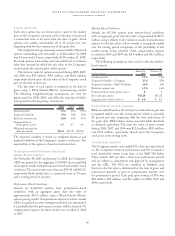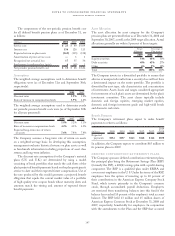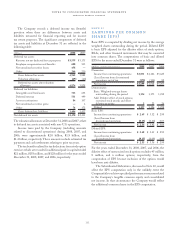American Express 2008 Annual Report Download - page 106
Download and view the complete annual report
Please find page 106 of the 2008 American Express annual report below. You can navigate through the pages in the report by either clicking on the pages listed below, or by using the keyword search tool below to find specific information within the annual report.
notes to consolidated financial statements
american express company
104
summary of stock plan expense
The components of the Company’s pretax stock-based
compensation expense (net of cancellations) are as follows:
(Millions) 2008 2007 2006
Restricted stock awards(a) $141 $135 $137
Stock options(a) 73 78 80
Portfolio grants and other 21 63 58
Performance/market-based stock
options(b) 2— —
Total compensation expense, pretax(c) $237 $276 $275
(a) As of December 31, 2008, the total unrecognized compensation cost
related to unvested RSAs and options was $217 million and $90 million,
respectively. The unrecognized cost for RSAs and options will be recognized
ratably over the weighted-average remaining vesting period of 2.3 years and
2.2 years, respectively.
(b) As of December 31, 2008, the total unrecognized compensation cost related
to unvested performance-based and market-based options was $33.8 million
and $8.0 million, respectively.
(c) The total income tax benefit recognized in the income statement for stock-
based compensation arrangements in 2008, 2007 and 2006 was $83 million,
$96 million and $96 million, respectively.
note 20
retirement plans
The Company sponsors defined benefit pension plans, defined
contribution plans and defined benefit post-employment benefit
plans for its employees. The following table provides a summary
of the total cost related to these plans as of December 31:
(Millions) 2008 2007 2006
Defined benefit pension plan cost(a) $ 13 $ 28 $ 124
Defined contribution plan cost(a) 211 173 106
Defined benefit post-employment
plan cost 27 31 39
Net periodic benefit cost $251 $232 $ 269
(a) Amendments to the U.S. defined benefit and defined contribution plans
were effective in the third quarter of 2007. Therefore, the 2007 defined
benefit plan pension costs are net of a $63 million curtailment gain. These
amendments are further described in the next paragraph.
In January 2007, the Company approved amendments to the
U.S. American Express Retirement Plan (the Plan) and the
Supplemental Retirement Plan (the SRP) effective July 1, 2007,
which provided that active participants immediately vested in
their accrued benefits, but no longer accrue future benefits
other than interest credits under the plans. As a result of this
action in 2007, there was a net reduction in the projected
benefit obligation of $91 million and a related curtailment
gain of $63 million ($39 million after-tax) on the date the plan
amendment was approved. As a result of these changes, the
Company modified the existing defined contribution plan in
the United States to provide for greater Company contributions
as further described in the Defined Contribution Retirement
Plan section of this note.
The following sections provide additional information
relating to each of these benefit arrangements.
defined benefit pension plans
The Company sponsors the Plan for eligible employees in the
United States. The Plan is a noncontributory defined benefit
plan and was amended effective July 1, 2007. The Plan is a
qualified plan under the Employee Retirement Income Security
Act of 1974, as amended (ERISA). The benefits are funded
through a trust. The Company’s funding of retirement costs
complies with the applicable minimum funding requirements
specified by ERISA, as revised under the new Pension
Protection Act (PPA), effective October 1, 2008. The funded
status of the Plan on an ERISA basis as of October 1, 2008
(plan year) is 104 percent (under the PPA calculation) and
120 percent for 2007 (under the calculation prior to PPA).
The PPA calculation assumptions are specific to ERISA and
differ from the calculation of net funded status for GAAP
purposes. (See Net Funded Status as of December 31, 2008 in
the table below).
The Plan is a cash balance plan and employees’ accrued
benefits are based on notional account balances, which are
maintained for each individual. Employees’ balances are
credited daily with interest at a fixed-rate that is updated each
January 1 and is based on the average of the daily five-year
U.S. Treasury Note yields for the previous October 1 through
November 30. The interest rate varies from a minimum of
5 percent to a maximum equal to the lesser of (i) 10 percent
or (ii) the annual maximum interest rate set by the U.S.
government for determining lump-sum values. Employees and
their beneficiaries have the option to receive annuity payments
upon retirement or a lump-sum payout at vested termination,
death, disability or retirement.
The Company also sponsors an unfunded non-qualified SRP
for employees compensated above a certain level to supplement
their pension benefits that are limited by the Internal Revenue
Service. The SRP is a supplemental plan that was also amended
as of July 1, 2007, and its terms generally parallel those of the
Plan but the SRP’s definition of compensation and payment
options differ.
The Company’s significant defined benefit pension plans
cover employees in the United States and United Kingdom.
Most employees outside the United States and United Kingdom
are covered by local retirement plans, some of which are funded,
while other employees receive payments at the time of retirement
or termination under applicable labor laws or agreements. The
Company complies with the minimum funding requirements
in all countries.
























